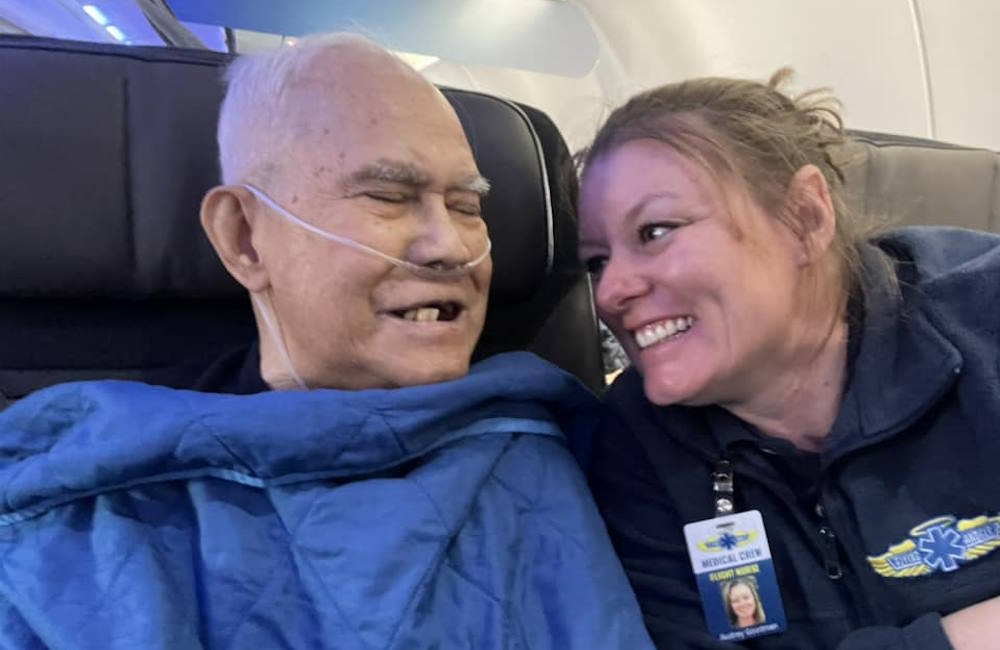
For individuals who rely on supplemental oxygen, the thought of flying can be daunting. Air travel already comes with its own set of challenges, and the need to bring along an oxygen tank adds another layer of complexity. However, the good news is that flying with an oxygen tank is not only possible but also manageable with the right preparations and knowledge.
The following will walk you through the essential steps and considerations for flying with an oxygen tank, ensuring a safe and stress-free journey. The hope is to provide information to those who use an oxygen tank, including those who fly with COPD.
The Federal Aviation Agency Rules on Flying With an Oxygen Tank
The Federal Aviation Administration prohibits passengers from bringing compressed oxygen cylinders or canisters on board due to the significant risks they pose, such as the potential for explosion or fire. However, they provide a list of portable oxygen concentrators (POC) that meet the safety and performance standards required for in-flight use.
Passengers who rely on an oxygen tank must ensure they have enough batteries to last the entire flight, including any unforeseen delays, and these spare batteries must be properly protected to prevent damage. As of September 2024, the FAA has approved more than 20 POC models, including the Freestyle Comfort, SeQual Eclipse 5, Respironics SimplyGo Mini, and Respironics SimplyGo.
The Transportation Security Administration (TSA), part of the Department of Homeland Security, permits portable oxygen concentrators that meet FAA specifications to be brought on board commercial flights for use during the journey.
What is a TSA Notification Card?
Preparing for Your Flight
After securing your POC, the next step is to notify your airline well in advance of your travel date. Most airlines require at least 48 hours notice if you plan to use a POC on board. During this time, the airline will likely request a letter from your doctor, confirming your need for oxygen and detailing your prescribed oxygen flow rate.
Additionally, airlines may ask you to provide documentation that your POC is approved for air travel and that it has been tested and maintained according to the manufacturer’s instructions.
When you arrive at the airport, inform the check-in staff and security personnel that you are traveling with a POC. The device will need to go through security screening, but you will be allowed to keep it with you at all times. TSA officers are trained to handle medical devices, so they will guide you through the process.
Onboard the aircraft, make sure your POC is placed under the seat in front of you, with the tubing properly secured to avoid tripping hazards. The cabin crew will be aware of your oxygen needs and will be ready to assist, if necessary. Some people feel more secure traveling with a flight nurse who can support them with expert medical care throughout the journey.
Do Individual Airlines Have Rules About Flying With an Oxygen Tank?
Most airlines have their own specific rules and requirements for traveling with portable oxygen concentrators (POCs). While the FAA sets the overall guidelines and safety standards, individual airlines may impose additional procedures or restrictions. Some common aspects where airline-specific rules might apply include the following.
Advance notice. Most airlines require passengers to inform them in advance — typically at least 48 hours before the flight — if they plan to travel with a POC. This allows the airline to make necessary arrangements and ensure compliance with safety regulations.
Medical documentation. Airlines may ask for a letter from your healthcare provider stating your need for oxygen, specifying the flow rate required, and confirming that you are medically fit to fly. Some airlines have specific forms that need to be filled out by your doctor.
Battery requirements. Airlines usually have specific rules regarding the number of batteries you need to carry for your POC. While the FAA recommends having at least 150% of the battery life needed for the duration of the flight, some airlines may require even more. Additionally, spare batteries must meet certain safety standards, such as being protected against short circuits, typically by placing them in protective cases or covering their terminals.
Approved POC models. Although the FAA provides a list of approved POCs, some airlines might have their own list of devices they permit on board. It’s essential to verify with your airline that your POC is approved for use during the flight.
In-flight use. Airlines might have specific instructions on how and when you can use your POC during the flight. For example, some may require that the POC be used only when the “fasten seatbelt” sign is off, or they may have designated seating areas for passengers using medical devices.
Seating arrangements. Some airlines might assign specific seating for passengers using POCs, often near a power outlet (if available) or in seats that do not block emergency exits. You may need to confirm your seat assignment in advance to ensure it meets your needs.
Airlines might have additional policies, such as requiring a backup device or charging a fee for carrying a medical device on board. Always check with your airline for their specific rules and policies. The following links will take you to the rules for some of the most popular airlines.
- Alaska Airlines
- American Airlines
- Delta Airlines
- JetBlue Airlines
- Southwest Airlines
- Spirit Airlines
- United Airlines
Flying with an oxygen tank or portable oxygen concentrator requires some extra planning, but it is entirely feasible. By understanding the regulations, choosing the right equipment, and preparing thoroughly, you can ensure a safe and comfortable flight. Always consult with your healthcare provider before traveling to make sure all your medical needs are met. With the right preparations, the skies are open to everyone, even those who rely on supplemental oxygen.
For more detailed information, refer to the Federal Aviation Administration’s (FAA) guidelines on traveling with oxygen and consult with your airline directly to understand their specific policies.
